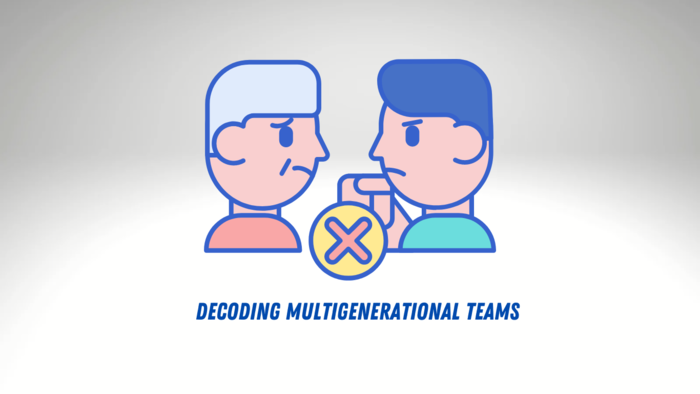Decoding Multigenerational Teams: Ditch the Playlist, Align with Learning Styles
I remember driving to Florida with my Mom and Dad, Brother and my Grandma. We had some cutting edge technology in the car - a tape deck. It was off the hook. You could put a tape in and listen to any music and not have to wait for the DJ to decide to play the song you liked! You could just pop the tape in and magically you’d be grooving to your favorite tunes.
Trouble was, Dad came from the traditionalists generation, Mom came from the Baby Boomers, my brother was GenX, me I’m a Cusper and Grandma the Greatest Generation. So figuring out how to curate the music on the twenty-six hour drive was nothing short of impossible.
Workplaces today are a Multigenerational Management Mashup at the best of times. Trying to discover how to decode and connect our team can feel like trying to connect an Abacus to Open AI and asking it to wash your car.
So then, how do we connect the Old School and New Cool? What is the best through line that can help managers accomplish alignment of a multigenerational team. For the last 20 years my company, Team Building School, has been using the team's Multiple Intelligence Quotient to do just that.
What we discovered was that while Zeitgeist and preferences gained from generational influences definitely frame a lot of what happens with workers. Multiple Intelligences is a way to strip the generational bias away from the individual and utilize a shared path based on their understanding that “good team building is good team learning.”
They found that the best way to unite multigenerational work teams was through learning preferences. Harvard Professor Howard Gardner wrote a book, “Frames of Mind” which detailed for educators eight different learning styles (i.e. Mathematical Logical, Visual Spatial, Body Kinesthetic, etc.) Gardner proposed that we could help aid our students in finding meaningful career paths by applying their learning strengths to modalities required to do well in a chosen career path (i.e. Kinesthetic Intelligence - construction, policing, physical therapist or Mathematical Logical - accounting, lawyer, software).
Interesting right?
Well you can take it one step further. You can assess your team for their learning intelligences. Plot their top three intelligences on a spider graph and easily see where the areas of high concentration are for particular intelligences within your team.
This way you can deliver workplace management based on the learning modalities of the people in the room. You can choose management techniques that matter to that individual (or team) of learners.
For example, if you are giving out a reward or recognition and you have a team member who is a highly Intrapersonal Learner you should not give the recognition out necessarily in a large group with lots of hoopla … it will likely encourage them not to accomplish that recognition again. Or how about you’re planning a team retreat and want to gather some ideas. You have a team that scores high in Kinesthetic. Instead of sending an email to get ideas, ask them to toss some answers in a hat at a quick stand up meeting. Their attention to detail for emails is not as highly attuned as their strength in delivering quick immediate responses.
Some of the other ways that Multiple Intelligences has helped managers to better lead their teams include areas like:
Choosing team events.
Choosing rewards and recognitions.
Choosing ad hoc or project teams.
Choosing meeting debriefs & icebreakers.
Choosing training events.
Choosing new supervisors.
Choosing message delivery.
Choosing communication plans.
Choosing discipline strategies.
Choosing how to facilitate, direct or delegate work.
While your generational differences can definitely play a part in how you see the world and those in it. Learning is a vehicle that has wired the way our brain works, how we feel success, informs the work we like to do, and has been with us since day one (regardless of when our day one started). If as a manager you can tap into learning intelligences you will be better able to mainline successful management mashups.
Stop trying to figure out what song to play on the tape player to appease everyone in the car. It doesn’t exist. Grandma wanted Lawerence Welk - my mom the Beatles - and my brother a little New Order… There was little chance of alignment that day for music. So instead, we shared stories, we all scored high in Interpersonal Intelligence (Mom, Dad and my Brother in Sales, Grandma a Receptionist and Me a Motivational Speaker).
That's how Old School met New Cool on the drive to Florida. Take a moment and think, what are the common learning strengths of your team members. From there, start to think about what tools and techniques will take your team to new levels by linking their learning preferences with management outcomes.
That's the tape you play on your journey to Florida.
AUTHOR
Tyler Hayden CSP, is a keynote speaker like you’ve never experienced before! Since 1996, Tyler continues to be a sought after internationally respected team building designer, best-selling author, and business speaker. He delivers a powerful punch that inspires teams, innovates management techniques, and invigorates team engagement.
His team building workshops and motivational keynote speeches receive rave reviews from managers and business leaders alike. "Energizing," "hilarious," "who knew learning could be this much fun." and "ideas I can easily implement," are things regularly said by Tyler's clients about his keynotes and team building events.
He is the author of over twenty-five books and the creative mind behind 100s of powerful and fun team building products including: The Business that Cared About People, Virtually Engaged Team Building Activities, The 14-Minute Mentor, Livin' Life Large, Father's & Mother's Message in a. Bottle, TEAM Activities, and More.
Tyler is a thought leader who works internationally with Fortune 500, Inc 5000 and Premier Associations to level-up their learning design. Tyler's innovative gamification and in-depth understanding of multiple intelligences yields programs that increase engagement and learning in amazingly simple ways.











